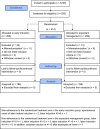Labor induction at 41+0 gestational weeks or expectant management for the nulliparous woman: The Finnish randomized controlled multicenter trial
- PMID: 38112629
- PMCID: PMC10867371
- DOI: 10.1111/aogs.14755
Labor induction at 41+0 gestational weeks or expectant management for the nulliparous woman: The Finnish randomized controlled multicenter trial
Abstract
Introduction: Neonatal and maternal risks increase in term pregnancy as gestational age advances and become increasingly evident post-term. Management practices of late- and post-term pregnancies vary, and the optimal time point for intervention by labor induction is yet to be determined.
Material and methods: This randomized controlled trial of 381 nulliparous women with unripe cervices compared labor induction at 41+0 gestational weeks (early induction) with expectant management and labor induction at 41+5 to 42+1 gestational weeks (expectant management). This multicenter study included all five university hospitals and the largest central hospital in Finland. The study period was 2018-2022. Participants were randomized to either early induction (48.8%, n = 186) or expectant management (51.2%, n = 195) with equal randomization ratios of 1:1. This was a superiority trial, and the primary outcomes were rates of cesarean section (CS) and composite of adverse neonatal outcomes. The trial was registered at the ISRCTN registry (ISRCTN83219789, https://doi.org/10.1186/ISRCTN83219789).
Results: The rates of CS (16.7% [n = 31] vs. 24.1% [n = 47], RR 0.7 [95% CI: 0.5-1.0], p = 0.07) and a composite of adverse neonatal outcomes (9.7% [n = 18] vs. 14.4% [n = 28], RR 0.7 [95% CI: 0.4-1.2] p = 0.16) did not significantly differ between the groups, but the operative delivery rate was lower in the early induction group than in the expectant management group (30.6% [n = 57] vs. 45.6% [n = 89], p = 0.003). The rates of hemorrhage ≥1000 mL and neonatal weight ≥4000 g were also lower in the early induction group, as was the vacuum extraction rate in women with vaginal delivery. Of the women with expectant management, 45.6% (n = 89) had spontaneous onset of labor. No perinatal deaths occurred, but one case of eclampsia appeared in the expectant management group.
Conclusions: Offering labor induction to nulliparous women at 41+0 gestational weeks may decrease the probability of operative delivery, postpartum hemorrhage, and neonatal weight ≥4000 g. However, this study was underpowered to affirm the trends of rising rates of CS and adverse neonatal outcomes in the expectant management group. Thus, expectant management could remain an option for some, as one in two women with expectant management had a spontaneous onset of labor.
Keywords: expectant management; labor induction; late-term pregnancy; post-term pregnancy; prolonged pregnancy.
© 2023 The Authors. Acta Obstetricia et Gynecologica Scandinavica published by John Wiley & Sons Ltd on behalf of Nordic Federation of Societies of Obstetrics and Gynecology (NFOG).
Conflict of interest statement
The authors declare no conflict of interest.
Similar articles
-
Induction of labour at or beyond 37 weeks' gestation.Cochrane Database Syst Rev. 2020 Jul 15;7(7):CD004945. doi: 10.1002/14651858.CD004945.pub5. Cochrane Database Syst Rev. 2020. PMID: 32666584 Free PMC article.
-
Association between timing of labor induction and neonatal and maternal outcomes: an observational study from China.Am J Obstet Gynecol MFM. 2024 Oct;6(10):101456. doi: 10.1016/j.ajogmf.2024.101456. Epub 2024 Aug 15. Am J Obstet Gynecol MFM. 2024. PMID: 39151749
-
Induction of labor vs expectant management among low-risk patients with 1 prior cesarean delivery.Am J Obstet Gynecol. 2025 Mar;232(3):321.e1-321.e10. doi: 10.1016/j.ajog.2024.06.001. Epub 2024 Jun 7. Am J Obstet Gynecol. 2025. PMID: 38852849
-
Induction of labour at 41 weeks versus expectant management and induction of labour at 42 weeks (SWEdish Post-term Induction Study, SWEPIS): multicentre, open label, randomised, superiority trial.BMJ. 2019 Nov 20;367:l6131. doi: 10.1136/bmj.l6131. BMJ. 2019. PMID: 31748223 Free PMC article. Clinical Trial.
-
Induction of labour at 41 weeks or expectant management until 42 weeks: A systematic review and an individual participant data meta-analysis of randomised trials.PLoS Med. 2020 Dec 8;17(12):e1003436. doi: 10.1371/journal.pmed.1003436. eCollection 2020 Dec. PLoS Med. 2020. PMID: 33290410 Free PMC article.
Cited by
-
Comparison of balloon catheter, oral misoprostol, or combination of both for cervical ripening in late-term and post-term nulliparous women: A Finnish randomized controlled multicenter pilot trial.Acta Obstet Gynecol Scand. 2025 Feb;104(2):389-399. doi: 10.1111/aogs.15034. Epub 2024 Dec 13. Acta Obstet Gynecol Scand. 2025. PMID: 39673223 Free PMC article. Clinical Trial.
-
Perinatal death in the Nordic countries in relation to gestational age: The impact of registration practice.Acta Obstet Gynecol Scand. 2024 Dec;103(12):2381-2391. doi: 10.1111/aogs.14950. Epub 2024 Nov 5. Acta Obstet Gynecol Scand. 2024. PMID: 39498817 Free PMC article.
-
Maternal and perinatal outcomes after implementation of a more active management in late- and postterm pregnancies in Sweden: A population-based cohort study.PLoS Med. 2025 Jan 16;22(1):e1004504. doi: 10.1371/journal.pmed.1004504. eCollection 2025 Jan. PLoS Med. 2025. PMID: 39820829 Free PMC article.
References
-
- Linder N, Hiersch L, Fridman E, et al. Post‐term pregnancy is an independent risk factor for neonatal morbidity even in low‐risk singleton pregnancies. Arch Dis Child Fetal Neonatal Ed. 2017;102:F286‐F290. - PubMed
-
- Olesen AW, Westergaard JG, Olsen J. Perinatal and maternal complications related to postterm delivery: a national register‐based study, 1978‐1993. Am J Obstet Gynecol. 2003;189:222‐227. - PubMed
Publication types
MeSH terms
LinkOut - more resources
Full Text Sources
Medical


